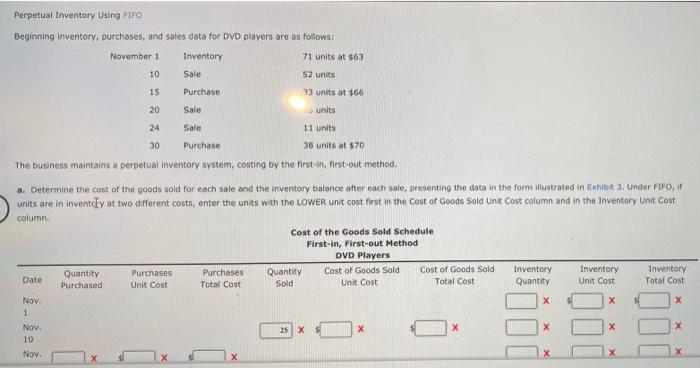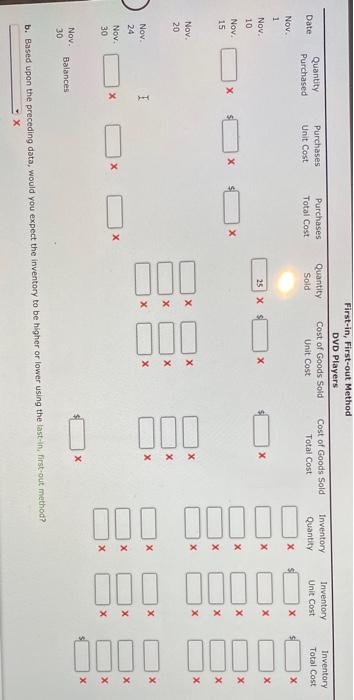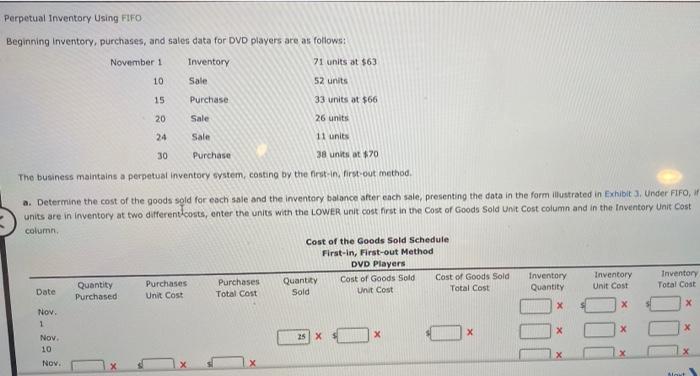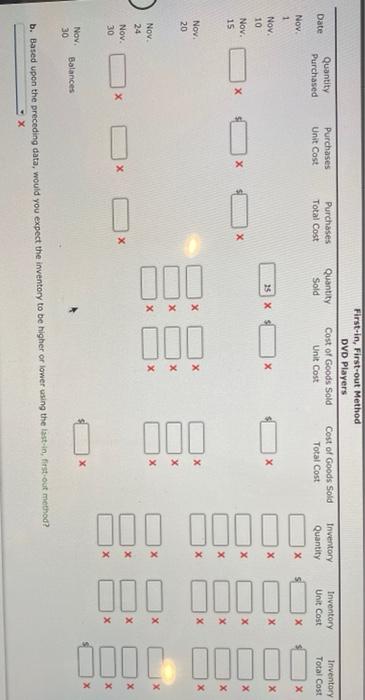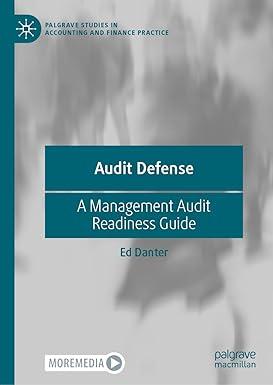Perpetual Inventory Using FIFO Beginning inventory, purchases, and sales data for DVD players are as follows: November 1 Inventory 71 units at $63 10 Sale 52 units 15 Purchase 23 units at $66 20 Sale units Sale 24 11 units 30 Purchase 38 units at $70 The business maintains a perpetual inventory system, costing by the first in first-out method. a. Determine the cost of the goods sold for each sale and the inventory balance after each sale, presenting the data in the form illustrated in Exhibit . under FIFO, units are in inventdly at two different costs, enter the units with the LOWER unit cost first in the Cost or Goods Sold Unit Cost column and in the Inventory Unit Cost column Cost of the Goods Sold Schedule First-in, First-out Method DVD Players Purchases Quantity Purchases Quantity Cost of Goods Sold Cost of Goods Sold Inventory Inventory Date Inventory Purchased Unit Cost Total Cost Sold Unit Cost Total Cast Quantity Unit Cost Total Cost Nov 1 Nov 25 X X 10 Nov. First-In, First-out Method DVD Players Quantity Cost of Goods Sold Cost of Goods Sold Sold Unit Cost Total Cost Quantity Purchased Purchases Unit Cost Purchases Total Cost Inventory Quantity Date Inventory Unit Cost Inventory Total Cost X s X X Nov 1 X x 25 X X X Nov. 10 Nov. 15 o X X X X X X x X Nov 20 X III IIIII Ill 100 0001 101 X X X X X X X Nov. 24 X Nov 30 o X X X X X Nov. 30 Balances b. Based upon the preceding data, would you expect the inventory to be higher or lower using the last in, first-out method? Perpetual Inventory Using FIFO Beginning inventory, purchases, and sales data for DVD players are as follows: November 1 Inventory 71 units at $63 10 Sale 52 units 15 Purchase 33 units at $66 20 Sale 26 units 24 Sale 11 units 30 Purchase 38 units at $70 The business maintains a perpetual inventory system, costing by the first in first-out method a. Determine the cost of the goods sold for each sale and the inventory balance after each sale, presenting the data in the form illustrated in Exhibit 3. Under FIFO, units are in Inventory at two different costs, enter the units with the LOWER unit cost first in the cost of Goods Sold Unit Cost column and in the Inventory Unit Cost column Cost of the Goods Sold Schedule First-in, First-out Method DVD Players Purchases Purchases Quantity Quantity Cost of Goods Sold Cost of Goods Sold Inventory Inventory Inventory Date Unit Cost Purchased Total Cost Sold Unit Cost Total Cost Unit Cost Total Cost Quantity Nov. X X 1 X X 25 X Nov 10 NOV. X n First-in, First-out Method DVD Players Cost of Goods Sold Cost of Goods Sold Unit Cost Total Cost Date Quantity Purchased Purchases Unit Cost Purchases Total Cost Quantity Sold Inventory Quantity Inventory Unit Cost Inventory Total Cost X Nov 1 . 10 Nov. 15 X X o X X o X X X X Nov 20 lll 111 XX X X X DI[ DIDIO Il bi jih Nov 24 x Nov. 30 X X X Nov 30 Balances b. Based upon the preceding data, would you expect the inventory to be higher or lower using the last in, first-out method? X
